

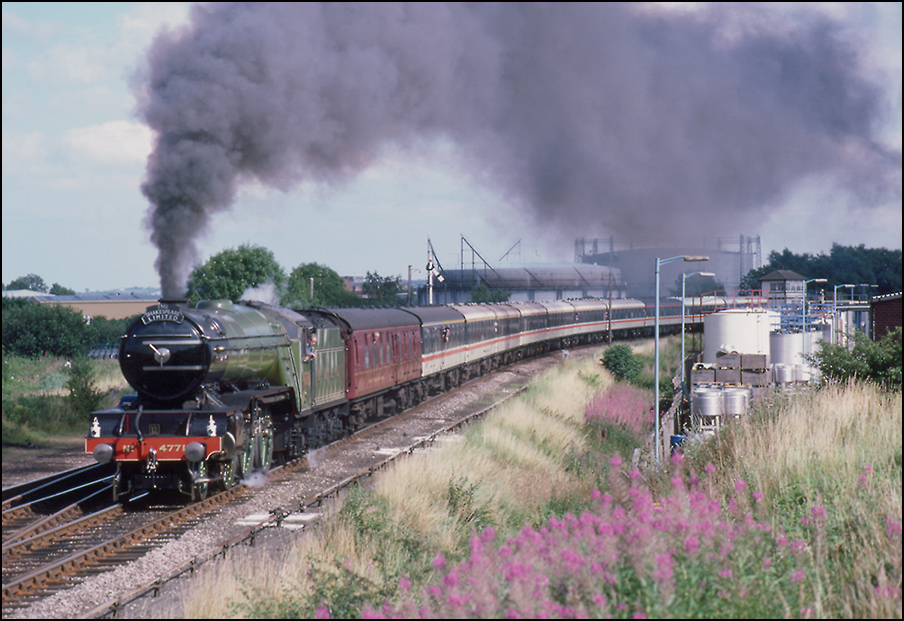
To many of my friends, this section will come as something of a surprise. I decided to put some of my steam collection online because some 20 years after most of them were taken the nostalgic content of them is, to me, quite strong. I spent quite a few Sunday afternoons in 1985 and 1986 taking photographs of the weekly dining trains from Marylebone to Stratford-upon-Avon together with occasional runs from Birmingham. Most of the pictures were taken quite close to my home and although some of the locations are shown more than once, I hope that the different locomotives will compensate for this.
I have rarely photographed steam since the late 1980s, not because I dislike the machinery; it is more down to the attitude and bigotry of a minority of those who avidly follow steam. I hope that this small selection of images will be of interest and bring some memories both of the trains and some long-gone railway infrastructure, not to mention a few locations that are no longer available through either undergrowth or building work. The pictures are in roughly chronological order, and I have grouped together workings by each locomotive in order to give a feel of how the trains ran in 1985 and 1986.|
|
|
|
|
|
|
|
|
|
|
|
|
|
|
|
|
|
|
|
|
|
|
|
|
|
|
|
|
|
|
|
|
|
|
|
|
|
|
|
|
|
|
|
In the late 1980s I had several trips to the Settle and Carlisle line, one of these being on 27 July 1988 when 4498 Sir Nigel Gresley worked north over the line. This picture is at Arten Gill viaduct where the wind was blowing in the right direction to move the exhaust away from the train. This run was filmed from a helicopter for the BBC and it was just possible to spot the small group of photographers at this location when the programme was aired. |
|
|
Gresley Pacific 4498 visited my home town of Stratford-upon-Avon on the sunny day of 21 August 1988. Unlike on this occasion and on 11 September 1988 the exhaust this time was more photogenic as the train rounded the curve by the site of the now long-gone Stratford Canning factory, to which access was usually granted if the right security guard was on duty. 645 |
|
|
Great Western Railway King class locomotives were not allowed onto the line through Stratford-upon-Avon in steam days because of at least one weight restrictions, this being the bridge over the River Avon a couple of miles south of the town. It was therefore notable when 6000 King George V came to the town on 19 June 1983 and I went to the lineside near Stratford East signalbox to take a shot of its arrival. This picture was taken on colour print film with a basic compact camera and in the absence of a negative the slightly faded print had to be scanned and put through several stages of post-processing. |
|
|
Attitudes to wandering about the railway at stations were more relaxed when this picture at Stratford-upon-Avon was taken although it was a Sunday and there was no train service to the town at all on Sundays including 19 June 1983 when this picture was taken. It shows GWR KGV 6000 during the shunting process after arriving at the town with the first ever visit of a King. |
|
|
Another preserved GWR King to run on the mainline was 6024, King Edward I. On 13 April 2002 it worked the 08:14 Birmingham Snow Hill to Paddington with a headboard more appropriate to earlier days. My picture was taken at Whitnash to the south of Leamington Spa as the train climbed the bank towards Harbury at full chat with steam to spare. I do not believe in trying to recreate past times but a scene of this sort would have been seen here many times over the years when Kings worked the primary expresses over this route. I also took a colour slide at the same time but do prefer the black and white photograph. I did take some video footage and although the picture quality isn't great, the sound is pretty good when played through decent speakers. |
|
|
A steam locomotive that achieved world-wide fame, or maybe notoriety, is 5972 Olton Hall when it appeared as "Hogwarts Express" in the Harry Potter series of films. It was painted into a red colour scheme which can better be scene in this video clip This run on 17 November 2002 must have been well publicised in the local press as there were several young Harry Potter fans on the scene although none wearing wizards' hats or brandishing magic wands... |
|
|
On the same day that the picture above was taken at Whitnash, 17 November 2002, another steam special passed Whitnash but heading north from London Marylebone to Nottingham. I wasn't aware of this working until another photographer arrived and told me that B1 61264 was only a few minutes away. The couple living near the line probably waiting in their garden for Olton Hall so also had a bonus shot. |
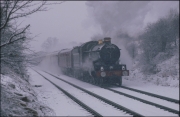 |
Saturday 7 March 1987 was quite a day. There was a blizzard in Warwickshire and this coincided nicely with the running of a steam special to Stratford-upon-Avon behind 5051 Dryswllyn Castle. Here is the return working approaching Wilmcote station with falling snow doing its best to obscure the scene. I am so glad I wasn't on board the train as the steam heating failed and the passengers were turfed off at Tyseley station because the operating conditions became untenable. The station buildings were locked and not even a lavatory was made available for the passengers. |
|
|
Despite the weather on 7 March 1987 there were many photographers at Wilmcote; including the 6 of us early arrivals at the platform end I think that there were around 60 at Wilmcote. The GWR footbridge has never been the same! |
|
|
The weekend of 7th and 8th June 1986 saw the North Warwickshire host an intensive steam service between Birmingham Moor Street and Stratford-upon-Avon. Two locomotiveswere used, 7029 Clun Castle and 5593 Kholapur, with both doing chimney-first runs in each direction with turning moves from Stratford to the trianle at Hatton and back. The first train was hauled by 5593 which is seen here approaching Wythall station taken from a lineside field. The light wasn't great at any point on the Saturday and a lot of my colour slides were a bit of a waste of film but I also took black & white shots which were more satisfactory. |
|
|
The steam specials between Birmingham Moor Street and Stratford-upon-Avon over the weekend of 7th and 8th June 1986 were operated with one set of stock and two locomotives, one facing each way with appropriate turning moves on Hatton triangle. The first return from Stratford on the 6th was with 7029 Clun Castle and this shot shows it a short way north of Wythall stations. Attitudes were different in 1986 about trackside photography on lines with no more than an hourly DMU in each direction... |
|
|
I stuck with Wythall for Clun's return from Birmingham Moor Street but walked to the other side of the station to another handy spot for this picture as the train pulled away from a speed restriction though the platform. |
|
|
At Wythall I had teamed up with another photographer whose name I now forget but do remember that he had a very nice Porsche 924 in which he gave a lift for later shots. He suggested Earlswood for the first northbound run of 5593 and this picture was taken from the site of the station yard as the train approached the station with the footbridge between the two parts of the wood in the background. |
|
|
The light picked up a little for Kholapur's return from Moor Street on 7 June 1986 and as the view from the roadbridge at Earlswood station was much more open in 1986 that was the spot for the next picture. |
|
|
Clun Castle was next in line for a run to Stratford-upon-Avon on 7 June 1986 and the next chosen location was a bit further south as the train left Wood End tunnel. By this time the light had virtually gone and it was touch and go if a sharp image would be possible. The colour slide I took cvertainly isn't! This is the only tunnel on the North Warwickshire Line and in the days I used to travel regularly by train it was sometimes a lottery as to whether the guard would switch on the DMU's interior lights in time. This was my last shot on the Saturday with hopes for better weather on the following day. |
|
|
Steam specials between Stratford-upon-Avon and Birmingham Moor Street continued on Sunday 8 June 1986. I decided to concentrate on the Wilmcote area and set off to walk along the canal towpath and while approaching the 2 railway bridges 5593 Kholapur came tender first towards the station light engine. This was a grab shot as there wasn't much time to get a camera ready. Needless to say, this view is now completely overgrown. |
|
|
Next along on 8 June 1986 with a train going to Stratford was 5593 which arrived in slightly brighter weather which gave a chance for a half-decent colour slide. This was taken from the other side of the bridge from the one above and with Wilmcote station in the background. |
|
|
If I remember correctly there was plenty of time for a walk to Wilmcote village for something to eat and drink in the Masons Arms, now closed, before 5593 had run to Hatton trianle, turned and returned to Stratford for the next trip north. There appears to be two small plumes of smoke in the left background with some dry vegeation having been set alight by embers from Kholapur. With this being a Sunday the weekly dining train from London Marylebone was also running but on this occasion it was diesel-hauled from and to Banbury becauseof The logistical difficulties a third steam locomotive on the line would have caused. I was irritated at the time that the only shots in full sun were of 45103 on both the down and up journeys. Time has since changed my mind as steam locomotives have been much commoner at Stratford than class 45s and I can recall only 3 or 4 having been to the terminus over the years. |
|
|
I didn't take pictures of every single movement on Sunday 8 June 1986 and my next was this one of 7029 just about to reach the summit of the 1/75 gradient of Wilmcote Bank. Clun Castle was being worked with load 12 which was above the official limit for an unassisted Castle although on summer Saturdays with very heavy northbound traffic a temporary lack of pilot engines or bankers saw a single locomotive with a load of 13 well-filled coaches cope perfectly well with the bank. |
|
|
This view of 7029 near Wilmcote on 8 June 1986 was taken as the train went away down the bank because there was a large crowd of photographers in front of me. We all were standing on the site of the Up Refuge Siding used in steam days to get slow moving freights out of the way of northboound expresses. |
|
|
In my final shot over the weekend of 7th and 8th June 1986 5593 was photographed absolutely roaring up the final few yards of Wilmcote Bank. As a Great Western fan it pained me to admit that Kholapur won the noise contest over Clun Castle with this run. I learned afterwards that the crews of both locomotives had a wager on which topped Wilmcote Bank at the highest speed. Both claimed that they did... |
|
|
Stanier Black 5 44932 visited Stratford-upon-Avon on Saturday 1 April 2023 and I that thought a shot of a steam locomotive chimney leading would be worth a trip. The majority of such trains to Stratford either run via Hatton North and Claverdon or in the case of The Shakespeare Express are worked tender first. I discounted a couple of locations in the Birming suburbs because of intrusive undergrowth and ended up at Danzey station and arrived to find a flock of photographers clustered around the one spot which allowed a view of the train passing the replica of a GWR running-in board. I went as far away as possible in an attempt to include some of the trees often sees at Great Western country stations and the daffodils recently planted by the local adopters of the station. The train, 1Z70, was around 20 minutes late arriving in the Birmingham area but by missing out a couple of short pathing stops was early as it joined the North Warwickshire Line. This was bad news as it rapidly caught up with a 5 car class 172 on 2S30 from Kidderminster to Stratford and coasted through Danzey instead of being able to put a good display of exhaust for the camera. |
|
|
While out for a walk on Sunday 26 March 2023 I heard the distinctive sound of a GWR Castle blowing off steam. It seemed to come from Wilmcote Bank and even after I had walked to the station which took nearly 10 minutes the safety valves were still open as it stood by the roadbridge. No waste of water there then... I had forgotten that 5043 Earl of Mount Edgcumbe was on its First solo run with The Shakespeare Express so took a couple of shots with my phone as it stood taking water after running round the stock. Here is a video sequence of that process. |
|
|
Stratford-upon-Avon station water crane 2023 style! There are no decent watering facilities for steam locomotives at Stratford-upon-Avon but there is a fire hydrant on the other side of the road running between the Alcester and Birmingham main roads. Cars have been known to belt along here so it is necessary for a Vintage Trains crew member to on duty to ensure that the hosepipe isn't damaged or torn out its mountings. Another man from the crew was pulling coal forward in the tender for the remaining trips of the day. |
|
|
I had forgotten about this shot until I saw the negative while looking for something else altogether in one of my 35mm folders and shows 35028 Clan Line being watered in platform 1 at Stratford-upon-Avon on 14 October 1987. I have no idea about from where the train came but it did arrive in the late afernoon behind 47508 with an ETHEL to provide power and the arrival of Clan Line was imminent. My picture was taken with the camera sitting on my aluminiun case in the absence of a tripod and its a minor miracle that the picture is sharp and moderately well-exposed! I took several but most of them had too many "ghosts" of crew and onlookers moving around. |
|
|
I had a few trips to the Settle and Carlisle line with a work colleague in 1988 primarily to photograph steam workings. In 24 August 1988 34092 City of Wells hauled The Pennine Limited and despite travelling a lot of the way north in sunshine the usual S & C curse operated and thick cloud was everywhere when we arrived at Horton In Ribblesdale. City of Wells was doing its usual impression of a volcano on wheels as it climbed towards Ribblehead and Ais Gill summit and passing the slightly tatty-looking signalbox. |
|
|
After Horton-in-Ribblesdale on 24 August 1988 we went straight off to a spot just beyond Moorcock Tunnel and the short Lunds viaduct. We heard 34092 whistle for the Tunnel and just as it exited it the sun somehow began to come out. This was a bit annoying as I had the left my camera with colour slide film in the car but in retrospect think that a black and white picture is much more effective and atmospheric. |
|
|
The final picture of 34092 City of Wells on 24 August 1988 was less dramatic than the earlier ones as The Pennine Limited was going downhill near Armathwaite. Note the platelayers' hut on the right and the ancient-looking telegraph poles, albeit without any wires, on the left. |
|
|
I have always liked Great Western Castle locomotives so when 5043 Earl of Mount Edgecumbe made its first test runs between Tyseley Steam Trust and Stratford-upon-Avon on Friday 24 February 2023 I had a walk to the station for a couple of pictures. It was unfortunate that a signaller decided to put a 6 car class 172 into platform 2 once 5043 had run round its single coach even though it was booked into P3. It was a bit dark under the station canopy but the swirling steam helped a bit as the crew brought the headlamps along the platform to mount on the brackets. |
|
|
The unwanted presence of a 6 car class 172 in platform 2 at Stratford-upon-Avon on 24 February 2023 didn't exactly help when taking a picture of 5043 Earl of Mount Edgecumbe leaving the station with a return of a test run from Tyseley Steam Trust. Even though 5Z42 was hauling only its support coach the locomotive sounded good as it ran along platform 1 and all seemed well for a loaded run later in the day to Humberstone Road at Leicester and back to Tyseley via a circular route. It's been over 11 years since last I saw 5043 when it made a run through Hatton on 29 October 2011. |
|
|
A rare private charter with double-headed Castle locomotives was shown to run from Birmingham Snow Hill to Didcot on Saturday 4 March 2023 so following my less than succesful trip to photograph 5043 Earl of Mount Edgecumbe it was, I thought, worth a trip out. The light was dreadful and with a departure time from Snow Hill of 08.18 I knew that it would be a bit of struggle to get a decent image. The train, 1Z29, picked up passengers at Widney Manor but then had to use the Up and Down Goods Loop at Dorridge so would be accerating hard once onto the up main line which boded well for a piece of phone video. My location was near Lapworth station and it was possible to hear the Castles opened up once they were on the up main line and althought it's a bit of a bland background the sound made it worthwhile. Here is my film clip on YouTube which is a bit shorter than I would have liked because of road traffic. |
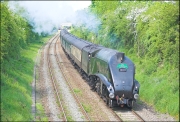 |
I made one of my exceptionally rare trips to photograph a steam working on 14 May 2008. A4 Pacific 60019 Bittern was in charge of a 1Z82 "Cathedrals Express" from London Victoria to Stratford-upon-Avon with a lunchtime arrival just late enough for the sun, if out, to be in the right place in the cutting just south of Wilmcote. Quite why the train carried this particular headboard is a mystery; I've lived in the Stratford-upon-Avon area all my life and have to find a cathedral in the town! Anyway, I combined taking this shot of Bittern just about to shut off steam for the descent to Stratford with a good walk along the adjacent canal's towing path and arrived with about 20 minutes to spare. The thought that there was a speeed restriction through the plaftorm of Wilmcote station was dispelled when I heard the rasp of an A4 working hard as it left Bearley Junction and continued accelerating until just after this shot was taken. |
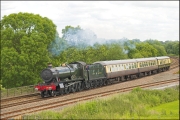 |
The weather forecast for the afternoon of Monday 23 June 2008 was good for the Midlands and with one or two interesting workings on the GWR line between Leamington Spa and Tyseley I decided to have a trip over to Hatton North Junction. The first working to appear was GWR 4936 Kinlet Hall with 3 coaches forming 5Z36 Merehead Quarry to Tyseley. The locomotive had made an appearance at the Open Day at Merehead and was running back to base. There was a water stop booked at Oxford but also lengthy layovers at Banbury and in Hatton Down Goods Loop but I thought that early running would be more than likely and sure enough, 5Z36 was heard to whistle for Hatton station at 15.16, nearly 80 minutes early, and appeared about one minute later chattering nicely around the curve at North Junction. This is very approximately the scene that appeared here for many years in the days of real steam as a Hall and 3 coaches would regularly have been rostered for Leamington Spa to Birmingham Snow Hill services. Naturally, this was just about the only train of the session that didn't appear in bright sunshine! At this time one of the co-owners of Kinlet Hall was my friend James White whose black and white photographs of steam around Stratford-upon-Avon appear elsewhere in this section. |
|
|
There were 2 steam movements at Small Heath within a short while of each other on 22 March 1986. The first was 777 Sir Lamiel on its way to Tyseley with a support coach after bringing The South Yorkshire as shown below to Saltley. It must have returned to the London area before long as it worked several times on the Sunday dining trains to Stratford-upon-Avon between May and July of the year and some pictures of these will be found elsewhere in this section. |
|
|
Following the locomotive change at Saltley from 777 to 75069 on 22 March 1986 the latter hauled the train forward to its destination although I don't know where this was and even Six Bells Junction for once has no details other than a couple of pictures taken on Small Heath station. This picture shows the train accelerating away from Bordesley Junction as a clas 116 DMU goes towards Birmingham Moor Street station. |
|
|
The embankment of the then newish M42 just north of Water Orton was a very decent spot for photographing northbound trains on the Birmingham to Derby fast lines in 1988. I used the location many times but this is one of the few steam workings I saw there. The train was a 1Z43 London Marylebone to Sheffield which had Black 5 5305 in charge and which appears to have produced some black smoke at just the right time. This line once saw countless workings with this class of locomotive but I can't imagine that any others looked so artificially clean and shiny as this one did on 21 May 1988.645 |
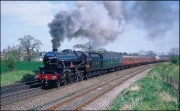 |
LMS Class 5 5305 is seen here making a lively ascent of Hatton Bank on 23 April 1988. I was here to photograph the Hastings DEMU on Leamington Spa to Stratford-upon-Avon shuttles, but wasn't going to miss the relatively rare chance to photograph a steam working in the afternoon in this location as most run in the morning so it made a change not to have a backlit subject. This train had started from Princes Risborough and returned later that evening. |
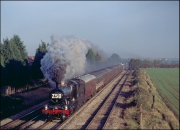 |
One of the smaller GWR locomotives to be allowed onto the main line was 2-6-0 7325. I didn't know this train was running on the morning of 4 November, having gone to Ashchurch to photograph 37411 on another railtour. The sight of this engine thrashing away like a small volcano was too much resist and although the transparency from which this image was scanned was badly under-exposed, the result isn't, I think, too bad. Note the mandatory centre headlight tied by cords to the buffer beam; as if one couldn't see this coming! My notes are a bit sketchy, but I seem to remember that the working was from Stourbridge Junction to Swansea, although I think the loco failed somewhere en-route. 645 |
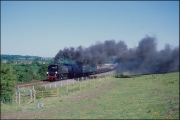 |
A Southern Railway mobile volcano, 34092 City of Wells, is seen here on 11 June 1988. It is climbing Wilmcote bank with the 16.25 Stratford-upon-Avon to Marylebone Shakespeare Limited. The combination of a stiff breeze going in the wrong direction and relatively soft exhaust resulted in the smoke blowing down over the carriages. One of the pleasures of steam traction is the smell of the smoke - I received a good lung full on this occasion.... |
|
|
Another picture from the site of the landfill site just outside Stratford-upon-Avon shows 4771 Green Arrow ascending the 1/75 of Wilmcote Bank with The Shakespeare Limited to London Marylebone on 16 August 1987. Even at around 16.30 the sun was quite harsh and on a hot afternoon it was a good job that some firing was taking place or no exhaust would have been visible. |
|
|
More black smoke, this time at Andover as BR Standard Tank 2-6-4 80080 leaves the station with an NSE special from London Waterloo. The steam leg of the tour started here with 33114 + 33021 having brought the train from the capital. I don't know why a single coach was removed from the train but guess that the load might have been too great for a relatively small locomotive. There weren't many photographers around for this train, at Andover at least, and the combination of very poor weather and Network South-East stock probably put some people off... |
|
|
After some images of preserved steam, back to the infinitely more interesting real thing with some previously unpublished and quite superb pictures from James White of Stratford-upon-Avon. This is one of my favourites and shows GWR 7808 Cookham Manor entering Stratford station with a westbound freight in the early 1960s. The loocmotive was in a nicely clean condition and there are traces of white paint on the buffers so it may be that it had been on special duties, possibly the Royal Train, in the recent past. The backdrop to the picture is of as much interest as the train itself with the town gasworks and gas-holders prominent and not to mention the steam shed (84E). |
|
|
As Stratford-upon-Avon GWR had an engine shed, 84E, there was also a coaling stage. In this picture by James White, Collett 0-6-0 2211 is alongside it waiting for its tender to be filled both with coal and water. Coal wagons were propelled up the incline on the other side of the structure from which the fuel was transferred by hand to small tubs which were then pushed onto a cantilevered ramp and tipped into the locomotive's tneder or bunker. The awning on the far side was there to provide the labourers with some protection from the elements while unloading the main line coal wagons. The excellent Warwickshire Railways website has much more information and plenty of photographs showing the coal stage here. There were usually one or two of the Collett 0-6-0 locomotives somewhere around Stratford. They were latterly used for local trip freight freights and for assisting nothbound main line trains on the 1/75 climb to Wilmcote. In most cases they banked the train as far as Wilmcote station but on occasions they were coupled inside a Castle or Hall and worked through to Birmingham Snow Hill as shown in a picture by Michael Mensing showing 2211 with 5089 approaching the summit of the bank. |
|
|
Another of James's pictures at Stratford-upon-Avon's coaling stage shows Churchward designed 2-6-2-Prairie tank 4133 with a trace of steam from the whistle about to move away after its bunker has been refilled. The 22,500 gallon water tank on top of the building and another on the other side of the station near Stratford West signalbox, were filled from the GWR-owned Stratford canal with the inlet placed near Wilmcote and above the short flight of locks made necessary by the town's position in the Avon Valley and the consequent gradient going north. The shed's water crane, one of four in the station area, was a few yards in front of 4133. |
|
|
This is the interior of 84E, Stratford-upon-Avon GWR engine shed. The 2 pannier tanks had been withdrawn and were on their way to Bird's yard at Long Marston to be scrapped and the Midland 4F just visible would have come here for servicing after the Old Town shed had closed. The spot upon James was standing was about to be occupied by Collett 0-6-0 2211 which had just been coaled and watered. |
|
|
Stratford-upon-Avon's other railway was the Stratford-upon-Avon and Midland Junction. Old Town station as it was known was to the south of the GWR and crossed it on its way towards Broom Junction. In its later years the line was only lightly used and made a useful photographic location for anything passing underneath on the GWR route. On this occasion James White used this spot to photograph 4998 Eyton Hall heading south with a returning theatre special on the way to Oxford via the curve at Honeybourne. The sad-looking remains of some SMJ buildings are in the background but in 2022 there is absolutely no sign here that either railway ever existed. |
|
|
The SMJ bridge over the GWR main line south of Stratford-upon-Avon I mwentioned above can be glimpsed in this picture of 4074 Caldicot Castle by James White. The train, doing a good impression of a race special, is passing the GWR Racecourse Station at the far end of which is the SMJ overbridge. The line coming in from the right is the 1960 spur from the SMJ to the GWR the opening of which allowed the closure of the Midland line between Stratford and Fenny Compton. This entire area is now a car park for a foot and cycle path, The Greenway, which occupies the GWR trackbed as far as Long Marston. Just after the track had been lifted and before all the railway infrastructure had been demolished in 1986 I took this picture looking north from what would have been the up platform of the Racecourse station. On 13 April 2022 I took this image using my phone in approximately the same location as James's image of 4074 although with no reference points it is hard to be precise. |
|
|
Stratford-upon-Avon Old Town station had closed by the time that James White took this photograph of 6989 Wightwick Hall passing the platforms with a mixed freight from the Cheltenham line, via the 1960 spur from the GWR line, on its way towards Fenny Compton and Banbury. For an up-to-date comparison I took this view of what is now the Seven Meadows relief road on 13 April 2022 showing the short length of platform edging that was left when the rest of site was cleared. There was some controversy in 1964 when part of the disused station's platform was resurfaced at considerable expense when HM Queen Elizabeth The Queen Mother visted the town to officially open the restored Stratford-upon-Avon canal and the station was used to stable the Royal Train ECS. Her Majesty had alighted at the GWR station and the train was taken to Old Town until the following day. This photograph from Warwickshire Railways shows LMS Black 5 44919 entering the station having run south from the GWR line and having used the junction seen behind the first few wagons in this photograph taken by my father some time in the 1950s |
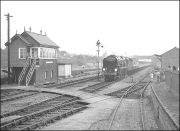 |
This picture shows 35028 Clan Line arriving at Moreton-in-Marsh on 4 October 1987 with a special train from Didcot. Main line steam was not as commonplace as it is today, which accounts for the crowd of interested locals thronging the secene. The train is heading for Long Marston depot in connection with the celebrations there to commemorate the 200th anniversary of the Royal Engineers. |
_m_in_m_1987.jpg) |
There was time for a walk to the roadbridge at the Honeybourne end of Moreton-in-Marsh station to take another shot of 35028 as it left. Most of the North Cotswold Line was single track at this time and the Sunday service was sparse to say the least so there would have been no pathing issues for the short run to Honeybourne where this locomotive was detached in favour of 8233 which was waiting to be attached to the rear of the formation before reversing and going over onto the Long Marston branch. Here is an image showing the track layout before redoubling took place in 2011. The class 37 and stock are standing in the Long Marston branch with the spur from the main line mid-way along the train with the ground frame at token inbstrument in the foreground. |
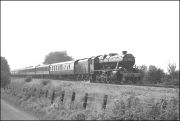 |
After the train arrived at Honeybourne on 4 October 1987 LMS 2-8-0 8233 was attached for the trip along the former Stratford-upon-Avon line to Long Marston. This line is particularly featureless with no overbridges until the entrance to the depot so this shot taken on the road to Broad Marston was about the best of a bad job. I remember struggling a bit with my camera on this day; I had just bought a Mamiya 645 1000S but the shop from which I obtained it did not have a prism finder in stock at the time. I was therefore having to use the supplied waist-level finder, which was fine for composition using a tripod for static subjects, but trickier for moving subjects. Perhaps it is fortunate that nothing was remotely speedy this day! I believe that this was the last time that a steam locomotive ran over the branch but cannot be 100% sure as my interest in steam waned a little in the 1990s. |
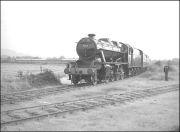 |
After arrival at Long Marston the passengers were treated to a ride around the depot's main loop behind 8233. The train is seen here about to enter the exchange sidings after its circuit of the camp. I also took some colour slides of some of the many circuits but the weather wasn't great and the black & white pictures better suited the scene in my opinion. |
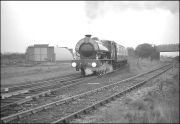 |
One of the MOD's own locos, 0-6-0 ST No.98 was also in operation during the afternoon offering rides around the depot's system with the full set of stock. This needed a great deal more effort than expended by the LMS 8F and was presumably more entertaining for the passengers as well as the photographers. The line to Honeybourne is seen disappearing under the new roadbridge which had been installed just 2 years earlier in 1985. |
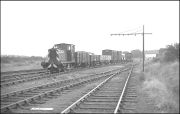 |
It was not purely a steam day at Long Marston on 14 October 1987 as one of the resident 0-4-0 diesel locos was used on a demonstration freight. The loading gauge is a reminder of the days when Long Marston despatched vast tonnages of freight for the MOD. The depot was last used in earnest for heavy traffic during the Falklands conflict in the early 1980s when many trains ran over an extended period. Sadly, I did not have the foresight to have recorded any of these movements. |
|
|
The LMS 8F 8233 was also used to haul some MOD freight wagons and equipment around the outer loop at Long Marston on 14 October 1987. The area around the bridge was virtually free of undergrowth at this time so the observers on the roadside would have a very decent view over much of the site. In 2021 the situation is very different... |
|
|
Another picture of 35028 Clan Line but this time climbing Wilmcote Bank just outside Stratford-upon-Avon with the Shakespeare Express on Sunday 10 May 1987. As the stock had electric heating and lighting it was necessary for ETHEL 2 to be included in the train and thus adding at least the weight of 2 additional coaches for Clan LIne to pull up the 1/75 gradient. The photograph was taken from a field, previously a landfill site, about 2/3 of the way up the bank. Not a pleasant place to stand on a warm day as some pungent smeels were still being released from the thousands of tons of festering rubbish buried on the site. |
|
|
Back to the "proper" steam power for the GWR lines in the Stratford-upon-Avon area. On an unrecorded date, probably a Saturday in the late 1980s, 7029 Clun Castle is taking a Birmingham to Paddington special through Leamington Spa. There is a steep adverse gradient for up trains known as "The Dip" made necessary because the line had to pass underneath a canal aqueduct a bit further north. |
|
|
The steam locomotive 6233 Duchess of Sutherland and its support coach ran from Tyseley to Southall on Monday 22 November 2021. I wouldn't usually have bothered with this but there was another working due to pass Hatton which I did wish to photograph so went a bit earlier to take advantage of the sun and Autumnal colours. The train running as 5Z34 left Tyseley late but was slightly early at Hatton through not running via a reversal at Small Heath South Junction as it left Tyseley pointing in the right direction. One of the usual hazards of taking pictures of steam arose as the exhaust did clear the locomotive body as it didn't need to do much work running downhill with a light load. |
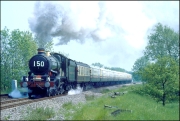 |
1985 saw the 150th anniversary of the formation of the Great Western Railway. Many events were held across the GWR's former territory and an exhibition train was put together which toured around the country. It was moved from Didcot to Birmingham on 4 June 1985 appropriately hauled by 5051 variously known as Earl Bathurst and Dryslwllyn Castle. It is seen here climbing Hatton Bank in the early afternoon photogrpahed from thje lieside adjacent to a boarded crossing which has since been replaced with a footbridge. |
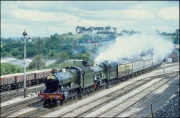 |
Saturday 6 July 1985 saw a double-headed run, the Western Stalwart, from Kidderminster when GWR Hall 4930 piloted Castle 7029. The train is seen here coasting past some attractive Great Western infrastructure at Droitwich, both up and down being loops in use, and real telegraph posts and wires in view. There were an awful lot of people here that day. Three rows of photographers stood on this bridge, the front row being on foot and the 2 rows behind them using various devices to gain height. One or two invaded the the coal yard and were in the shots of some photographers. I heard later that all 4 tyres of the car of the offending chaser had been deflated and assume that the two incidents may have been related... |
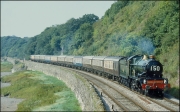 |
On 10 September 2005, 2 steam-hauled trains ran to South Wales. The first was this,"Samuel Whitbread 2" with 7029 Clun Castle in charge which I pictured skirting the Severn Estuary near Purton on the Gloucester to Chepstow line. This image was taken from the roof of an old permanent way hut which had probably never been intended to bear the weight of about a dozen photographers! |
|
|
The other train, Samuel Whitbread 1, was the cause of several hundred people visiting the Newport area on 10 September 1985. The Severn Valley's 2857 was allowed out for a rare main line trip with a motley collection of freight vehicles as part of a demonstration showing how Railfreight had progressed. This class of locomotive was commonplace in South Wales in earlier times, but I bet not many were ever found in the clean state to which 2857 had been prepared. It is seen here leaving the yard at Alexandra Dock Junction and about to head east to Newport station from where it did some interesting parallel running over the river Usk with the class 56 just visible in the background. |
|
|
As soon as 2857 with its brake force ballast wagons and demostration freight load had left Alexandra Dock Junction there was a mass exodus of several hundred bodies many of whom headed east towards a convenient car park near Newport station. This had a reasonable view over the bridge crossing the River Usk over which 56040 was due to make a parallel run with 2857. The light was all wrong and I did hear one of those present comment that the organisers might have timed it better just for him to get better pictures! |
|
|
The next port of call for people photographing 2857 and its demonstration freight on 10 September 1985 was the road bridge at East Usk where the branch to Uskmouth Power station diverged from the main line. |
|
|
The class 7 train hauled by 2857 was limited to 45mph and must have a caused a bit of a problem with pathing on the main line. I recall that it was getting quite late by the time it reached the River Wye bridge at Chepstow and the light was beyond the capabilities of the Ektachrome 100 35mm I was using. I had only one camera, an Olympus OM1n, in those days so didn't have the luxury of black & white to push things a bit further. The consist of the train had been altered by thgis time with the loaded ballast wagons having been removed although I don't know where this was done. |
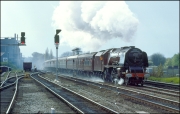 |
Changing railway companies and locomotive colour, another of the steamy highlights of 1985 was the move of 46229 Duchess of Hamilton to the London area for use on several trips to Stratford-upon-Avon. She came south on Saturday 4 May 1985 at the head of The South Yorkshireman. I had been at Leamington Spa in the morning and whilst chatting to the station supervisor, established that he had asked the signalman to check the train as it approached "the dip" approaching the station so as get a decent display of sound and exhaust when the locomotive was opened up once the signals cleared. Everything went according to plan and this image was obtained as the train accelerated towards the platforms on the up through road. |
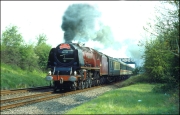 |
46229 made her first trip to Stratford-upon-Avon on 16 May 1985 with The Shakespeare Limited, a Sunday lunch dining train. The return working is seen here climbing Wilmcote bank on the way back to Marylebone and, as I remember, sounding quite magnificent. |
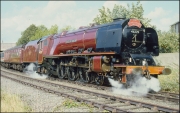 |
Another of the Duchess's runs to Stratford-upon-Avon took place on 22 September 1985 and I took this view of her as she prepared to propel the stock out the station and into the down goods loop. The locomotive was then coaled and watered before heading off to Hatton and Dorridge to be turned in preparation for the return to London. I had to wait for a few moments to let the condensing steam clear a bit after the cylinder cocks had been opened prior to moving. |
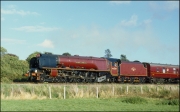 |
Here is the return working mentioned in the caption above as 46229 accelerated away from Stratford-upon-Avon. This piece of track is very slightly downhill which gives an enthusiastic driver the chance to build up some welcome momentum before attacking the 1/75 of Wilmcote bank. This location is now smack in the middle of an estate of small offices from which the railway line is invisible. One of the regular drivers on this turn was Gordon from Leamington Spa. He is seen here in characteristic pose, totally relaxed and fully confident in the abilities of himself, his fireman and the locomotive. See also the picture of Green Arrow at the front of this section. |
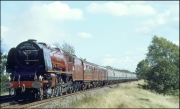 |
46229 returned north after her sojourn in the south of England on Saturday 5 October 1985. The train again carrying the South Yorkshireman headboard is seen here at the boarded foot-crossing just to the south of Hatton cutting, once again in the hands of Gordon. She was making very light work of the 1/110 average gradient with the 12 coach load. There was no superfluous smoke this time and the accompanying sound was not as loud as one might have expected. All in all, a locomotive working well within her capabilities. I was trying to fill the frame and succeeded a bit too well! |
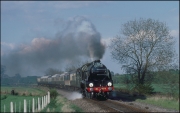 |
The Southern Railway locomotive 777 Sir Lamiel was another visitor to the Stratford-upon-Avon line in 1986. One of the first visits was an evening private charter, the 2060 Harrison Express. The train is seen here near Claverdon , on the single track from Hatton to Bearley Junction on 16 May 1986. |
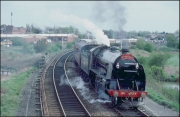 |
Sir Lamiel, Southern Railways No.777 had worked the Sunday dining train on the Sunday before the run shown above and Sir Nigel Gresley had also arrived at the terminus with a separate train. This generated an huge amount of interest, so much so that the BT police were around in force; an officer can be seen on the trackside to the left of the train. This meant that my favourite location on the "sunny" side of the tracks was not available so I asked the signalman if I might use his window for my picture. Although taken against the hazy sun, I don't think the shot turned out too badly. |
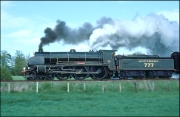 |
This panned shot was taken from a field adjacent to the line at Bishopton, a few hundred yards from Stratford-upon-Avon station. 777 is making the most of a short stretch of favourable gradient before the assault on Wilmcote bank begins. There is clearly plenty of steam, as shown by the lifting safety valves. |
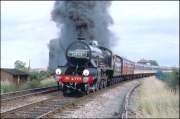 |
This picture is dated 6 July 1986 and depicts Sir Lamiel, this time running without smoke deflectors, doing an impressive imitiation of a volcano as it leaves Stratford-upon-Avon with the up Shakespeare Limited to London Marylebone. Gordon, the driver, is watching to see if I approved of the smoke effect earlier requested when chatting to him at the station. Oh yes... |
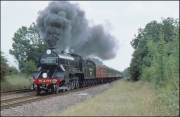 |
An equally impressive exhaust was in evidence the following Sunday, 13 July 1986, as 777 and its heavy 13 coach train topped Wilmcote bank on the way back to Marylebone. For a relatively small engine, Sir Lamiel proved more than capable of dealing with the 1/75 gradient with something around 420 tons on the drawbar, more than a GWR castle was officially allowed to work up here in steam days. That rule was sometimes broken on Summer Saturdays when there were many northbound trains in the evening and the pilot or banking engines were already tied up. |
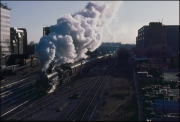 |
My final shot of Sir Lamiel in the 1980s is this somewhat impressionistic portrait as she leaves Marylebone on a shuttle to High Wycombe on 3 January 1987. Such is the height of the bridge parapet here, that it was necessary to either have high steps, or as I did, stand on the roof of a Land Rover owned by another of the photographers present! |
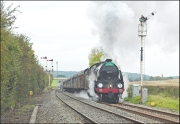 |
Before the class 33 locomotive 33025 sent to shunt the stock at Stratford-upon-Avon had gone out of sight towards Stratford-upon-Avon, 30777 was waiting at the signal on the single track from Hatton West Junction. It had picked quite a bit of time as it had reported 2 minutes late at Heyford but was now close to 15 minutes early. The signalman at Bearley Junction allowed to proceed under caution from the single track and his outer started was cleared just as the train came to the end of the speed restriction. With cylinder cocks open, the injectors on and with leaking cylinder glands, Sir Lamiel is making a fair impression of a hovercraft as the regulator is opened to get it on move towards its destination. I sometimes think that steam locomotives look better in black & white, especially in poor light. I shall have to be careful, this is the third steam run I have photographed in 2008... |
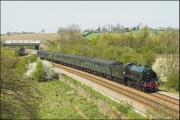 |
There was a steam hauled train to Stratford-upon-Avon on Friday 23 April 2010, St George's Day and the anniversary of William Shakespeare's birth and death. I have no interest in photographing steam workings, although I don't mind occasionally standing and watching one working hard, but as this one was coming within a short walk of my home and at a convenient time on a sunny day I thought that I would go and have a shot. The locomotive was 30777 Sir Lamiel, although for some reason it was pretending to be 30453 King Arthur and arrived at Bishopton, just outside Stratford, a few minutes late coasting slowly down the last few yards of Wilmcote Bank. The real 30453 looked very different to 30777 having being built at a different time and the product of a quite dissimilar design so the reason for the masquerade is unclear. Still, if I owned a Southern Railway steam locomotive I would have it painted in Network South East colours... |
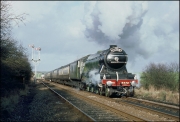 |
Turning now to the locomotives of the LNER, here is the most famous of their stable, 4472 Flying Scotsman, leaving Bearley Junction with a private charter from Birmingham to Stratford-upon-Avon on 12 July 1986. This had been a wet and cold day, but just as the signals were cleared for the train the sky cleared and out came the sun. Peak class 45, 45012 was provided for the return working. |
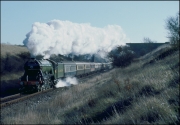 |
LNER 4472 is seen again here, this time hammering up Ardley bank, just north of Bicester, with one of 2 specials from Marylebone to Stratford-upon-Avon, which ran on 21 November 1986. The train had stopped at Bicester for the locomotive to be watered, and the sound of it coming to this location was marvellous. The work being done is clearly demonstrated by the terrific exhaust. This section of track has now been doubled and after a spell of little locomotive activity, does once again have the capacity for special workings. |
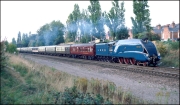 |
Gresley streamlined A4 4468 Mallard worked south from York on the afternoon of 4 October 1986 prior to working some Sunday trains from Marylebone to Stratford-upon-Avon. Predictably enough, this had been the source of a great deal of interest from the general public as well as photographers and I didn't want to go to one of the busier locations so decided on this spot near Olton, which was the cause of my trousers getting ripped and covered in blackberry juice. I was standing in position shortly before the train was due when a BT police van appeared on the trackbed of the former slow lines. Not wishing to get gripped, I dived into the undergrowth before realising it wasn't the most comfortable of hiding places! All was well though, and the van soon turned around and disappeared. |
|
|
The first of the dining trains hauled by 4468 from Marylebone to Stratford-upon-Avon ran on 21 November 1986. The light on the then single track north of Bicester was touch and go by the time the train was heard climbing Ardley Bank but it did stay out long enough for this shot to be taken. An earlier train behind 4472 Flying Scotsman had run earlier in the morning and had made a lot more fuss and noise than Mallard but I suppose that the latter had just been through a complete renovation and was to al intents and purposes a brand-new locomotive in tip-top condition. The two locomotives were coupled together at Stratford for the run to Hatton and Dorridge for turning and here is a shot of them passing Wilmcote cutting on way back. |
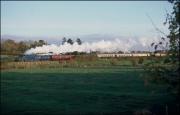 |
Here is the first of the returning trains on 21 November 1986. By the time 4472 left Stratford the sun had set meaning that no photograph was possible. This location at Bishopton is completely unreapeatable because of the construction of an estate of office buildings all around the line. |
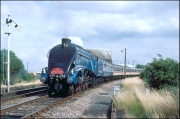 |
As will be obvious I tried to photograph each "new" locomotive to Stratford-upon-Avon in several of my favourite local spots. Here is 4498 leaving the terminus on 27 August 1986, passing the lower quadrant middle starter operated by the signalbox just about visible behind the bush on the left of the picture. There is little evidence on this hot afternoon of the hard work being performed by Sir Nigel as it lifts this heavy dining train across the Stratford-upon-Avon canal. |
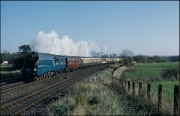 |
4468 returned to York at the head of the South Yorkshireman on 8 November 1986. Hatton was the obvious location, especially as a pair of class 33/2s was booked shortly before the steam. As it happened, Mallard appeared first as the diesel train had been slightly delayed south of Aynho junction. I have never seen so many people spread across the field at this location, nor such idiotic trespass as when many of them legged it as soon as Mallard had passed. These people, obviously unaware that this was a busy main line, simply ran down the track to the boarded crossing. Several of them were nearly collected by the 33s following only a section behind. |
|
|
I had forgotten all about photographing this train until the medium-format slide was found in a file of modern traction transparencies. It shows 71000 Duke of Gloucester at Culham with an Ealing Broadway to Derby charter on 29 April 1990. The locomotive had taken over the train at Didcot which accounts for the billowing clouds of black smoke; a contrast to the coal-fired power station in the background. I know we are supposed to like fields of flowering rapeseed in our pictures but I quite dislike the excessive and overhelming yellowness. If I recall correctly I was on my somewhere else and dropped in here as it is a convenient roadside location with plenty of parking space on the grass verge even on a day when something like this was running.645 |
|
|
I was out for a walk on the morning on Sunday 28 July 2019 and was crossing the road bridge at Stratford-upon-Avon station about 10 minutes before 8F 48151 was due to arrive with 1Z50 from Burton-on-Trent, a train operated by WCRC (probably much to the annoyance of Vintage Trains based at Tyseley!). I checked RTT and saw that 1Z50 was 9 minutes early passing Wilmcote and as I usually carry my Canon G10 when out and about stayed put. Within about 15 seconds I heard the train arriving but had to switch to the other side of the bridge as it was running on platform 2 rather than P1, as booked. This might give it an easier exit on the return to Burton in the expected wet weather given that it won't have to use the crossover from P1 to the up main line. I vaguely recall seeing the occasional 8F here in my spotting days when steam was real; I think they turned up now and again on a Washwood Heath to Honeybourne coal train although by that time 9Fs were more commonplace and on one memorable occasion gave me my one and only footplate ride; to Honeybourne with a tender-first light engine return. My mother's reaction when a very grubby and smut-covered 9 year old went home is best forgotten! |
|
The British Pullman with VSOE stock ran from London Victoria to Warwick Parkway on Wednesday 10 July 2019 with 35028 Clan Line providing the motive power. The only part of the itinerary that was of interest to me was when 5Z82 used Hatton Down Goods Loop during its ECS movement to Tyseley LMD for servicing. Any passenger stock is relatively unusual along the loop and I couldn't recall photographing such a train before today. The train was a few minutes late leaving Warwick Parkway and there was a Newcastle-bound CrossCountry service only a few minutes behind but this didn't get in the way of the shot as Clan Line chiffed its way up the bank towards Hatton station in some fortunately quite thick cloud; sun here at lunchtime would be useless for a shot of anything in the loop. The empty stock was later due to pick the passengers at Stratford-upon-Avon with 35028 running tender first taking the stock there via the North Warwickshire Line. It left Tyseley nearly 20 minutes late, arriving at Stratford 15 late leading in turn to a 35 minute late departure and because it needed both platforms 1 & 2 (P3 being occupied by a Chiltern unit) so that the locomotive was able to run-round the stock, causing significant delay to a London Midland service from Stourbridge Junction and its return to the West Midlands. The same locomotive was a regular visitor to Stratford in the 1980s and here is a picture of it standing just south of the station and again a few minutes after departure with driver Gordon White keeping an eye on things. |
|
|
I'm not sure what's going on but this is my third outing for steam so far in 2019. The locomotive was again Clun Castle and I do like this class having some admittedly fairly distant and hazy memories of them at Stratford-upon-Avon in the days when steam was real. On 26 February 7029 with 6 or 7 coaches was scheduled to make 2 runs to Stratford unusually operating as a class 1 train from Hall Green to Acocks Green; appropriate enough in view of Clun's impressive new coat of paint! I didn't bother with the tender-first inward trip but went to one of several foot crossings on the single line between Bearley Junction and Claverdon for 1Z72, the 12.53 from Stratford. The sight and sound was impressive, especially given the warm Springlike temperature of 17C, and I did enjoy the spectacle. |
|
|
Vintage Trains of Tyseley has, in October 2018, just been been granted a Train Operating Company (TOC) licence. The first train run under the licence was a 5Z65 Tyseley to Stratford-upon-Avon ECS and early morning chat suggested that 47773 would in charge. By the time I reached Edstone Aqueduct this allocation had changed to 4965, Rood Ashton Hall, which was quite a disappointment especially considering that it would be running tender first in this direction. Still, I suppose that the train is notable if only because of its tiny place in the history of the privatised railway. |
|
|
It could have been worse... On 11 November 2017 the Tyseley pannier tanks 9466 + 9600 ran to Stratford-upon-Avon and Kidderminster for their usual Autumnal ramble. I had not planned to photograph this as a 5V94 conveying a 350/2 for corrosion removal from Northampton EMD to Long Marston was down to run but this was cancelled and re-scheduled to work later in the day by which time it would have a bit too dark for my tastes. I therefore walked up to Stratford-upon-Avon Parkway Station as this is the nearest location to my home where the diminutive locomotives would be working hard. There was always a chance of the incoming class 172 getting in the way but I was happy enough to take the risk on the basis that I had never intended to take this image. Sure enough, the 172 from Stourbridge was in the platform as 1Z28 approached and the driver seemed to pause for quite a while after receiving and acknowledging the 2 buzz code to pull away from the guard. I simply put my 24-70mm zoom onto its widest setting and ran off about 10 shots as the panniers came through the station and actually quite like the result showing as it does the contrast between ancient and modern. Here is another view of the same locomotives taken a few years ago from the adjacent bypass bridge while the station was under construction. |
|
|
A VSTP working from Tyseley to Stratford-upon-Avon and back via the North Warwickshire Line ran on 4 May 2017. This had escaped my attention so when a friend pointed it out I decided that even though it was steam operated it worth be a worth a walk to Stratford Parkway station, about the only place on the line where the sun is at a decent angle at around 13.45. It is, after all, just over 4 years since the last time I saw a steam locomotive! The headcode was 5Z96 so it didn't need a lot of imagination to work out the the locomotive would be pannier tank 9600, built by the GWR in 1945 and it was entirely predictable that the inward journey would be with it running bunker first. This is perfectly acceptable as these engines were designed with this in mind unlike those with tenders which look ridiculous running the wrong way round. This location was under construction on 3 November 2012 when I photographed the same locomotive double-heading with 7752 on a train running around the West Midlands. I'm sure that "purists" would decry an image in this sort of spot as it makes no attempt at recreating anything and in my view it's much the better for it. |
|
|
Comedy corner at Hatton. Again... The worthwhile part of the trip was my sighting of a pair of Red Kites above a field at the corner of the Station and Pinley Roads on the way to station bridge; my first for this area. |
|
|
A charter train from London Euston to Worcester via the North Cotswold Line was booked for Saturday 9 March 2013. This, despite the doubling of large parts of the line, is relatively unusual so even though a steam locomotive, 34067 Tangmere, was the motive power I resolved to take a picture just for the record. The light was dire in the extreme and it was necessary to use ISO 800 with camera settings of 1/1000 at f5. I generally consider that if one needs a higher ISO than this to achieve a reasonable result then it's time to stay at home! I usually forget that wind direction is a factor in steam photography but this did come to mind on this occasion so with a slight easterly wind and no sun a shot from the north side of the line at Honeybourne would ensure that any drifting exhaust didn't obscure the train. I arrived about ten minutes before the train was due and it came along pretty much on time, travelling at quite a speed and in near silence. The return from Worcester was via Kemble and the Great Western main line to London Paddington but this leg of the journey went unrecorded, by me at least. |
|
|
I have, over the past few weeks, been recording progress at the developing site of Stratford-upon-Avon Parkway Station. Although changes in infrastructure are the main reason for regular updates the type of trains passing the site are generally going to be limited to DMUs of classes 165, 168 and 172 so when I was told that two of Tyseley Steam Trust's pannier tank locomotives were running to and from Stratford on Saturday 3 November 2012 I decided to record the movements in order to give a bit of variety to my photographs. The weather after a dull, wet and windy start to the day had begun to pick up a little by the time 9600 topping and tailing the train with 7752 (London Transport L94) were due and the sun made a few brief appearances during the walk from my home. Here is 1Z57, the 09.25 from Tyseley Warwick Road, passing the new station just about on time with its not very uniform but still quite attractive rake of seven chocolate and cream coaches. A top and tail formation for the locomotives was necessary because the train had had to run to Small Heath South Junction from Tyseley in order to reverse and gain the North Warwickshire Line and just for the record here is 7752 bringing up the rear of the formation. |
|
|
The departure from Stratford-upon-Avon of 9600 + 7752 was timed for 11.15 and with a rapidly clearing sky I walked round to the bridge on the A46 trunk road. I like quite extreme backlighting for steam as it makes for a dramatic exhaust and with the train, now running as 1Z58, just hitting the 1/75 gradient of Wilmcote Bank, a decent show of exhaust was guaranteed on a chilly morning. From a photographic point of view the fact that the locomotives were running bunker first was unfortunate but this had been made necessary because no reversal was apparently possible at Worcester, the train's destination, and it was preferable that they should run chimney first up the Lickey Incline later in the day. It must be said though that 1) pannier tanks were designed for bunker first operation and 2) it made absolutely no difference to the passengers who had paid their fares which enabled the train to run at all. Whatever the perceived shortcomings I was pleased to get this picture as I'm not aware of any other locomotive hauled trains, either steam or diesel, scheduled to visit Stratford before the new station opens in May 2013. The contractor's access to the site is by way of the temporary road visible to the right of the tracks which runs from the County Council's rubbish and recycling tip on the other side of the road. |
|
|
HM The Queen visited Hereford and Worcester on 11 July 2012, with part of the journey being by rail and with the steam locomotive 6201, Princess Elizabeth being in charge. The Royal Train left Worcester in the early afternoon and with no information available about routing I went to Norton Junction, near Worcester, as this offered the best chance of seeing the working whether it ran via either Cheltenham or Evesham. The location has become very overgrown in the last couple of years and is just about at the point where it's not worth the effort. The sun was out as 6201 approached the bracket signal showing that it was routed to Abbotswood Junction and Cheltenham, but a small cloud made itself only too apparent as just the wrong moment. I was rather hoping that 67026, here seen on the back of the train, would be leading but with the lack of sun I would have been more irritated than was the case. |
|
|
The new(ish) steam locomotive 60163 Tornado ran from Salisbury to Worcester on 28 June 2012. I hadn't previously seen it, despite it having visited my home town at least once, so I decided, for my annual steam shot to go to Lower Moor between Evesham and Pershore, a location at which I had seen most classes of locomotive at some point, in order to update my portfolio. The weather was fine when I left Stratford-upon-Avon but as I passed Evesham the sky grew black and lightning began to flash. The heavens opened when I reached Chadbury and driving become virtually impossible with zero visibility despite having my windscreen wipers on full speed. The road suddenly flooded to a depth of several inches as water flowed off the hills to the north but with nowhere to pull off the road it would have been more hazardous to have stopped than to continue at low speed. Not long after reaching Lower Moor the rain ceased, leaving a very humid and misty scene looking towards Fladbury and Evesham. The service trains, including this HST forming 1W29, the 11.21 from London Paddington, were slightly delayed which did give the hazy background a few extra minutes to clear a little before 60163 appeared. |
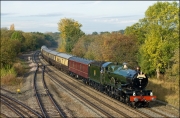 |
A 1Z30 09.57 private charter from Birmingham Moor Street to London Marylebone was planned for Saturday 29 September 2011. I had no idea what traction was scheduled for the train but with no water stops showing in the timings I assumed that a diesel, possibly 47773, would be in charge. Curiosity led me to Hatton and on arrival the presence of several other photographers made me suspect that steam might be involved and sure enough I soon learned that 5043 Earl of Mount Edgecumbe was on its way south. The lack of a water stop was explained by the fact that the first coach was a GUV with a water tank built in to give extra water capacity for the run to London. The roadbridge at Hatton station isn't the ideal spot for steam as it is quite likely that the train will be coasting down Hatton Bank and this was the case with just a wisp of steam coming from the safety valve bonnet to show that the locomotive was "live". To aid with shunting and turning ready for the return, class 47 47773 was on the back of the train. Running just in front of 1Z39 and on exactly the same route was the modern equivalent, on this occasion 168216. |
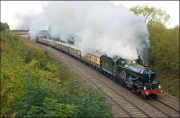 |
The first steam charter over the newly redoubled North Cotswold Line, after a ban on the previously single line lasting several years, ran on Saturday 17 September 2011. The train, 1Z79, started from Tyseley and ran via Birmingham Snow Hill, Galton Junction, Kidderminster, Worcester Shrub Hill and Norton Junction where it joined the North Cotswold Line. I very rarely photograph steam (or any other) charters but thought that a shot of a GWR Castle on this line would be worthwhile to increase my portfolio of shots in this area so headed off to the west of Evesham, where the train picked up passengers, knowing that the locomotive would be working hard to climb the ruling gradient of around 1/200 to Honeybourne before tackling the much steeper climb up Campden Bank. I had first thought of taking my photograph from the bridge over the cutting near Aldington but saw from the Evesham bypass that there were already several people waiting there and it also entered my head that it might be a bit gloomy in the cutting on such a dull and damp morning. The next choice was the bridge on the Offenham road where I was a little surprised to be alone, although after thinking about it, I suppose that the majority of photographers would probably have flocked to Moreton-in-Marsh where some lower quadrant semaphores are still extant. I heard 5043 Earl of Mount Edgecumbe open up shortly after leaving Evesham station and although not a great steam enthusiast must admit that she sounded magnificent as she passed by with plenty of steam to spare. |
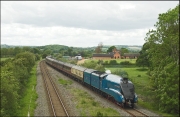 |
A relatively rare steam move over the North Warwickshire Line, that is with the locomotive working the correct way round unlike the summer Shakespeare Express trains, took place on Thursday 12 May 2011. The train, 1Z78 York to Stratford-upon-Avon, was hauled by A4 60019 Bittern, for some reason masquerading as something else, making what is probably the first run for a locomotive of its type over the line for quite some time. The ensemble complete with the extra tender to increase water capacity is seen about to pass under Edstone Aqueduct shortly after a family of appropriately named mallard ducklings, not pretending to be tufted ducks, swam along the canal making marginally more noise than the train underneath. |
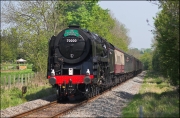 |
Saturday 23 May 2011 saw 70000 Britannia work from London Paddington to Stratford-upon-Avon. This made it exactly one year to the day since last I photographed a steam working so, as it was a nice day, I made the short journey to a convenient location on the single track between Hatton West and Bearley Junction. This photograph was taken from the right side of the fence, unlike those of some people further south whom earlier I had seen walking down the track. The train, 1Z40, arrived here just about on time and was coasting on the falling gradient towards Bearley. I think that quite a few largely identical photographs may have have taken around Wilmcote as when I drove home, the normally quiet road into the village was virtually blocked by several dozen cars... |
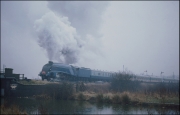 |
Here is 4498 Sir Nigel Gresley adding to the gloom, mist and general wetness as it leaves Stratford-upon-Avon for Marylebone on Sunday 16 March 1986. Strangely, as I write this on the morning of 22 December the weather conditions are almost exactly similar - not very seasonal! In retrospect, this shot would have beem much better in black and white, but I had only one camera in those days, so it was a case of "either/or" and I was half-way through a roll of K64 at the time. |
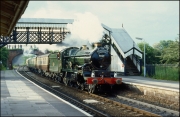 |
The weekend of 9 and 10 June 1985 saw quite an intensive steam service between Birmingham and Stratford-upon-Avon. 7029 Clun Castle was the featured locomotive, which is seen here passing the classic GWR station at Wilmcote. |
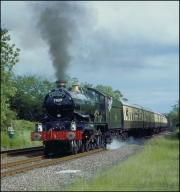 |
Later the same day, Clun Castle is seen here topping the 1/75 climb from Stratford-upon-Avon to Wilmcote. On summer Saturdays in the days of real steam working, many of the returning expresses from the West Country would have been double-headed from Stratford, the pilot engine having been sent down from Tyseley shed. As many as 6 or 8 locos would have been used in this way, such was the volume of traffic. The spot upon which I was standing for this shot was the location of an up refuge siding, used to get freights out of the way of the express passenger workings. Some of the loop's infrastructure was still visible at this time. |
_wilm_9685.jpg) |
The final train of the day is seen here in the same spot in some lovely evening light, albeit just missing the wheels and motion. Clun Castle performed faultlessly all day and sounded quite magnificent on the steep climb out of the Avon valley. The steam specials running today have to shut off at this point and reduce speed through the station at Wilmcote because of reduced clearances to the platform edges. |
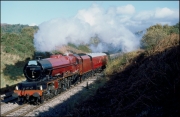 |
The other LMS express pacific locomotive around in the 1980s was 6201, Princess Elizabeth. Here she is about to top Llanfihangel bank on 30 October 1986 with her first test run after restoration. This isn't really my sort of shot, being in an anonymous piece of countryside with no real clue as to the location. There had a been a very sharp shower only a few minutes earlier with a fine rainbow appearing in the background. Needless to say, this, and the accompanying black sky had gone before the train appeared... |
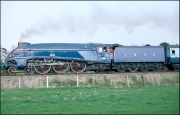 |
The sun didn't shine for 4498's visit to Stratford-upon-Avon on 27 April 1986 so I decided upon a panned broadside view. In retropsect I didn't stand sufficiently far back and missed the extreme front-end of the buffer... |
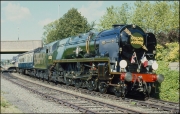 |
Going back to Southern Railway locomotives, here in 35028 Clan Line standing just south of Stratford-upon-Avon after arrival with the Sunday dining train on 15 September 1985. This date was close to 60th anniversary of the inaugural Golden Arrow and Clan Line carried the full impressive set of regalia to commemorate the event. |
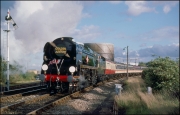 |
As 35028 was carrying the Golden Arrow regalia on 15 September 1985, I felt that I wanted a head-on shot of the train leaving Stratford-upon-Avon. Here it is passing the long-gone gasholders, with the signalman's car just being visible in front of the locomotive. |
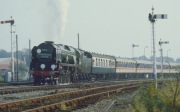 |
Here is a view of Clan Line a little closer to Stratford-upon-Avon station on 29 September 1985 framed by some of the semaphore signals still extant at the time. This locomotive sometimes had a bit of trouble leaving the station here with a heavy train and often slipped once or twice before going. The S curves on the first section of track and the short climb over the Stratford-upon-Avon canal didn't help either. |
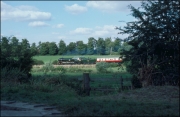 |
Another shot of 35028 shows the Sunday afternoon train to London Marylebone taken from the Bishopton lock on the Stratford-upon-Avon canal. I can't remember if the sun was coming or going, but at least it was shining on the train on the afternoon of Sunday 31 August 1986. The canal and lock are still here and quite busy with boat traffic but the view towards the railway is completely obscured by various developments of office units. |
|
|
I don't know exactly when this picture was taken but it was probably on a Sunday afternoon in late summer in about 1989. I was standing on the original roadbridge on Bishopton Lane just outside Stratford-upon-Avon on a very wet and dull day. The train was on its way to London Marylebone and the consist included the former class 25 renumbered 97252 coverted to provide electrical power to the train. The fields to both sodes of the line are now covered in office developments and the bridge has been been replaced with one with a much higher parapet. |
|
|
Tyseley Steam Museum provided LMS 5593 for a railtour that ran on 25 August 1986 which started from London St Pancras. The steam locomotive took over the train somewhere in the Birmingham area, probably Saltley, before going to Southport. This picture was taken between Bordesley and St Andrews Junctions with the locomotive and support coach running alongside the Camp Hill line with the former GWR goods shed in the background. |
|
|
LNER 4771 Green Arrow made a couple of trips from London Marylebone to Stratford-upon-Avon in 1987 and here is the Shakespeare Limited dining train returning to the capital on Sunday 2 August of that year. The driver, Gordon White, is in his characteristic pose showing complete confidence in both his own and the locomotive's abilities. The location for this shot was the lorry turning circle of a nearby food canning factory and it is was very much a matter of luck if access was granted; if the right security guard was on duty it was fine, otherwise forget it! |
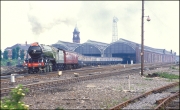 |
The centenary of Bank Top station, Darlington was marked on 5 July 1987 with a special hauled by 4771 Green Arrow of which my first sight was as it propelled its support coach to the station where the stock was waiting. The detail of the run has faded from my memory, but I do recall it running to Newcastle and Hexham. The train is here seen leaving Bank Top at the start of the journey. I took quite a few shots during the day, all on Fuji 50asa stock. This hadn't been my intention, but the very early start caused to pick up the wrong camera. In the conditions, 100asa slide film would have produced better images but I've put these few online just for the historical interest. |
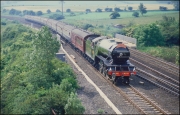 |
The next shot was taken at Tursdale. The North Road Museum Centenary Express is crossing from the East Coast Main Line to the Leamside line, then a diversionary route to Newcastle. The Leamside line has been mothballed since electrification of the ECML, with various lengths of track having been stolen since. Before the Hatfield crash Railtrack intended to reopen it and got as far as replacing the fencing, but Network Rail now intend to lift the track. Thanks to Francis Pritchard for information on the route. |
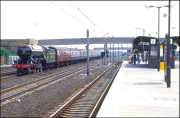 |
This photograph was taken at Pelaw Metro station and was obtained only through the kindness of a Metro driver who stopped his train outside the station so as not to block our view. |
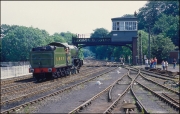 |
Green Arrow must have gone light engine from Hexham to somewhere else for servicing, as she is here seen arriving tender-first under the wonderful signalbox at that location. |
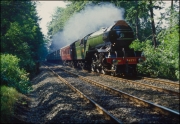 |
The final shot of the day is the one I really don't like, being taken in a wood somewhere outside Hexham. It represents everything I dislike in railway photography, no indentifiable background, a below track level shot and spotlight sun. I wasn't the driver for the trip so had no say in the choice of location. |
|
|
A casualty of the hot and dry weather of the 2018 summer was a steam special from Preston to Stratford-upon-Avon which had to be postponed until the threat of the countryside being set alight had passed. By 8 September everywhere was nice and damp so 46100 Royal Scot was allocated from Crewe. The train met about an hour's delay around Wigan because of a problem with the diesel locomotive used from Preston and this delay stuck for the rest of the journey. I don't have much of an interest in steam photography although I quite enjoy seeing and hearing the locomotives in action; what does put me off is the crowds that tend to gather in every single location. There is a spot near the station which I have meaning to check out for a while and I thought that 1Z48, the return to Preston, would be the ideal chance. It turned out to be not too great but I did bang off a few as 46100 prepared to leave. The smoke was a bit of a nuisance and the sun came out at the wrong moment but it gave me an idea of what might be possible if we ever get a decent train first thing on a summer morning. |
|
|
The exit from Stratford-upon-Avon is awkward for the crews of steam locomotives because it is on a adverse gradient, has some quite severe curvature and worst of all if the train is in platform 1 it has to negotiate a crossover to the up main a short distance from the station. It is quite usual for a diesel to give the train a shove and on 8 September 2018 D1935 was used as was working quite hard as I took this shot. The picture of Royal Scot leaving wasn't a success because of steam and smoke obscuring the front of the locomotive. The white tanker in view just in front of D1935 was the one used to water the steam engine; good to know that the tender tank and boiler won't be clogged up with weeds! |
|
|
I photograph a steam locomotive about once each year and took my 2019 images on 31 January when 45596 Bahamas visted Stratford-upon-Avon with a single coach while undertaking a lightly loaded test run from Tyseley. I don't recall having seen Bahamas on a previous occasion so made the short walk from my home to the station a few minutes before it was due to leave on 5Z63, the 12.52 return to Birmingham. I waited until the blower had been operated which livened up the fire and produced a small amount of black smoke to enhance the scene. The day was cold and dull which possibly explained the almost complete lack of enthusiasts on the station so getting a shot clear of bystanders was not too difficult. My stock of Jubilee photographs is limited to say the least but here is a picture of 5593 Kholapur approaching Danzey station at speed on 8 June 1983 while on the way to Stratford. The Jubilee should have worked turn and turn about over the whole day with 7029 Clun Castle but the former failed and 7029 had to work the northbound trains tender first which was, I was told at the time, the first time that a main line run with passengers had operated in this way. |
|
|
My intention was to take another image of Bahamas as it left Stratford so as to get a shot with some steam condensing in the cold air. In the event the cylinder cocks were open and by the time the locomotive had appeared through the clouds of water vapour it was too late! Here then is a closer-up view just before a class 172 from Stourbridge Junction pulled into platform 2 and obscured everything. Another of my small collection of Jubilee shots is this one of Leander as it climbed Wilmcote Bank on 3 July 2005. I had just bought a new telephoto lens and wanted to try it out on something that I wasn't too bothered about if it went wrong. I put the shot on this site and was roundly told off by a gentleman who took umbrage at my opinion that anything to do with steam didn't matter! |
|
|
My second trip of 2019 to photograph a steam locomotive took place on Thursday 21st February. This time it was to see 7029 Clun Castle on the first day of its loaded main line test runs when it ran between Tyseley and Stratford-upon-Avon. I waited until the later of the two runs and had it in mind to go to Hatton North Junction but couldn't be bothered when the time to leave home approached and also thought that if it ran at all late the shadows there might be a bit excessive. I therefore just walked to Stratford station and took a few stationary images as it prepared to leave watched by passengers waiting for the 16.26 departure to Stourbridge Junction. This view was taken as the crew out on the blower and began to build up the fire before the 1/75 run up Wilmcote bank. Talking of which, here is a picture of Clun Castle doing just that on 9 June 1985. |
|
|
There weren't too many people around to block the view as 5Z78 left so I stayed on the platform to take a shot. The cylinder cocks had just been shut so the image wasn't compromised by clouds of condensing water vapour. It is, unfortunately, compromised by the dreadful and cramped-looking Orbit Housing sink estate of the future which now looms over the entire area. While going through my slides of 7029, not a quick task given the state of my storage system, I found one of the locomotive as it skirted the Severn Estuary at Purton on 10 September 1985. The quite numerous bunch of photographers were standing on top of a slightly ancient PWay hut the roof of which, I seem to recall, didn't seem to be happy with our combined weight! |
|
|
A private charter from Didcot to Stratford-upon-Avon ran on Monay 21 October 2024 with GWR Castle 5043 Earl of Mount Edgcumbe providing the power for the 6 coach led plus 47773 which had taken the ECS and steam locomotive from Tyseley earlier in the day. It arrived right on time at 15.11 with the punters still finishing their lunch before being taken to a hotel in a chartered coach parked across the road. In earlier times before the end of steam and the closure of this line further south this picture would have been possible on countless occasions but obviously without all the modern bits and with quite a lot of "proper" infrastructure in view! |
|
|
Not an image for the steam purist but one showing the reality of the modern railway where it is not possible for so many reasons to recreate the past. I could have waited for 172338 to leave with the 12.26 to Worcester Foregate Street, 2V08, but a large number of people from 1Z65 were on their way so it was unlikely that a clear view of the whole train would have possible. |